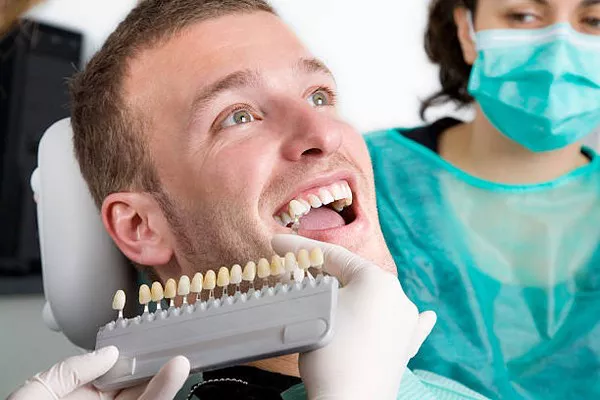When it comes to dental health, there are many misconceptions, especially regarding the color of teeth. One common myth is that yellow teeth are inherently stronger than white teeth. In this article, we will delve into this myth, explore what truly determines the strength of teeth, and provide practical advice for maintaining strong, healthy teeth while achieving a brighter smile.
Myth vs. Reality
The belief that yellow teeth are stronger than white teeth is widespread but unfounded. The myth likely stems from the observation that natural, unbleached teeth often appear more yellow and can be associated with robust dental health. However, tooth color alone does not indicate strength or health.
Reality Check: Tooth color is not an indicator of strength. The color of teeth is influenced by several factors, including genetics, age, and lifestyle choices, but these do not directly correlate with the structural integrity or strength of the teeth. The real determinant of tooth strength lies in the health of the enamel and the underlying dentin.
Enamel Health
Enamel and Mineral Content: The enamel, the outermost layer of the teeth, is the hardest tissue in the human body, composed primarily of hydroxyapatite, a crystalline form of calcium phosphate. The strength of enamel depends on its mineral content and overall health, not its color.
Understanding Enamel
Enamel is translucent; the color of the underlying dentin, which can range from off-white to yellowish, can show through. Healthy enamel protects teeth from decay and physical damage. Its strength is compromised when the enamel erodes, often due to acidic foods and beverages, poor oral hygiene, or other factors.
The Role of Dentin
Beneath the enamel is the dentin, a yellowish tissue that is softer than enamel but still vital for the tooth’s structure. The natural color of dentin is one reason why teeth may appear more yellow as we age; enamel wears thin, revealing more of the dentin.
Maintaining Enamel Health
To maintain strong teeth, it’s essential to preserve the enamel. Here are some key factors influencing enamel health:
Diet: A diet high in sugary and acidic foods can erode enamel. Consuming dairy products, which are high in calcium, and drinking water can help maintain enamel strength.
Oral Hygiene: Regular brushing and flossing remove plaque, which can erode enamel if left unchecked.
Fluoride Use: Fluoride strengthens enamel by aiding in the remineralization process.
Regular Dental Check-ups: Professional cleanings and examinations can catch early signs of enamel erosion.
see also:Unlocking the Secrets: How Much for a Deep Cleaning at the Dentist
Causes of Tooth Discoloration
Tooth discoloration can result from various factors, many of which do not affect the strength of the teeth. Understanding these causes can help address cosmetic concerns without compromising dental health.
Extrinsic Stains
Extrinsic stains occur on the outer surface of the teeth and are often caused by:
Diet: Consuming coffee, tea, red wine, and certain fruits can stain teeth.
Smoking and Tobacco Use: Nicotine and tar in tobacco products can lead to yellow or brown stains.
Poor Oral Hygiene: Inadequate brushing and flossing can allow plaque and stains to accumulate.
Intrinsic Stains
Intrinsic stains occur within the tooth structure and can be due to:
Aging: As enamel wears down, the yellow dentin becomes more visible.
Medications: Certain antibiotics (e.g., tetracycline) and medical treatments (e.g., chemotherapy) can cause intrinsic staining.
Fluorosis: Excessive fluoride during tooth development can lead to discoloration.
Genetic Factors
Genetics also play a role in the natural color of your teeth. Some people have naturally thicker or more translucent enamel, affecting how their teeth appear.
Safe Whitening Practices
While the desire for whiter teeth is common, it’s crucial to approach whitening safely to avoid damaging the enamel. Here are some recommended practices:
Whitening Toothpaste
Using a whitening toothpaste can help remove surface stains. These toothpastes typically contain mild abrasives and are safe for daily use. Look for products with the American Dental Association (ADA) Seal of Acceptance.
Over-the-Counter Whitening Products
Over-the-counter products, such as whitening strips and gels, can also be effective. Ensure these products are ADA-approved and follow the instructions carefully to avoid overuse, which can lead to sensitivity or enamel damage.
Professional Whitening Treatments
For more significant whitening, consider professional treatments from a dentist. These treatments use stronger bleaching agents but are monitored to ensure safety. Professional options include in-office bleaching and custom-fitted trays for at-home use.
Avoiding Harmful Practices
Avoid unverified home remedies such as using lemon juice or baking soda, which can be too abrasive and erode enamel over time.
Dental Care Tips for Strong and Healthy Teeth
Maintaining strong, healthy teeth involves consistent care and attention to daily habits. Here are some essential tips:
Regular Brushing and Flossing
Brush at least twice a day with fluoride toothpaste and floss daily to remove plaque and prevent decay. Use a soft-bristled toothbrush and replace it every three to four months.
Balanced Diet
Consume a balanced diet rich in calcium and phosphates, which support enamel health. Limit sugary and acidic foods and drinks.
Hydration
Drink plenty of water throughout the day, especially after meals, to help wash away food particles and acids.
Avoid Tobacco Products
Refrain from smoking or using other tobacco products, as these can cause staining and increase the risk of gum disease and oral cancer.
Regular Dental Check-ups
Visit your dentist regularly for professional cleanings and check-ups. These visits help catch early signs of problems and keep your teeth in top condition.
Use of Mouthguards
If you engage in contact sports or grind your teeth at night, use a mouthguard to protect your teeth from physical damage.
see also:Unveiling the Average Cost for a Deep Cleaning: A Comprehensive Guide
Consulting a Professional
For personalized advice and treatment options, consult with a dental professional. They can assess the health of your teeth, recommend appropriate whitening methods, and provide tips for maintaining enamel strength.
Personalized Dental Plans
A dentist can create a tailored dental care plan that addresses both cosmetic concerns and overall oral health. This plan may include professional whitening treatments, fluoride applications, and specific dietary recommendations.
Addressing Underlying Issues
If discoloration is due to underlying health issues, such as decay or enamel erosion, a dentist can treat these problems, ensuring your teeth are healthy and strong before considering whitening options.
Monitoring and Maintenance
Regular follow-ups with your dentist help maintain the results of any whitening treatments and ensure ongoing dental health.
Conclusion
The strength of your teeth is determined by the health of the enamel and the underlying dentin, not by their color. While yellow teeth are often perceived as stronger, this is a myth. The true indicators of strong teeth are a healthy diet, proper oral hygiene, and regular dental care. If you are concerned about the color of your teeth, there are safe and effective whitening methods available, but these should never come at the expense of enamel health. For the best results and to ensure your teeth remain strong and healthy, always consult with a dental professional.
FAQs about Teeth Color and Attractiveness
1. What color teeth is best?
The best color for teeth is generally considered to be a natural white. This shade is often perceived as a sign of good health and hygiene. Natural white teeth are not overly bleached or unnaturally bright; instead, they have a subtle, slightly off-white hue that resembles the appearance of healthy, untreated teeth. This color is typically achieved through regular dental care and sometimes professional whitening treatments that enhance the natural color without making them look artificial.
2. Is yellow teeth a big turn off?
Yellow teeth can be a turn off for many people as they are often associated with poor dental hygiene, smoking, or excessive consumption of staining substances like coffee, tea, and red wine. However, it’s important to note that teeth naturally have a slight yellow tint due to the dentin underneath the enamel. While slightly yellow teeth can be perfectly healthy, a noticeable yellow hue may affect one’s confidence and how others perceive them. Regular brushing, flossing, and dental cleanings can help maintain a whiter appearance.
3. Which Colour of teeth is strongest?
The strength of teeth is not determined by their color but by their overall health. Teeth with a natural, slightly off-white or light yellow tint can be just as strong as artificially whitened teeth. The enamel—the hard, protective outer layer of the teeth—plays the most critical role in determining their strength and resilience. Maintaining enamel health through good oral hygiene, a balanced diet, and avoiding excessive intake of sugary and acidic foods is crucial for strong teeth.
4. What is the most attractive type of teeth?
The most attractive type of teeth are those that are straight, evenly spaced, and have a healthy, natural white color. Symmetry and alignment contribute significantly to the overall attractiveness of teeth. A bright, natural smile with well-maintained teeth is often considered very appealing. Many people opt for orthodontic treatments, such as braces or aligners, to achieve this ideal appearance. Additionally, regular dental care, including professional cleanings and whitening treatments, can enhance the attractiveness of teeth by ensuring they are clean and free from stains and discoloration.
You Might Be Interested In































